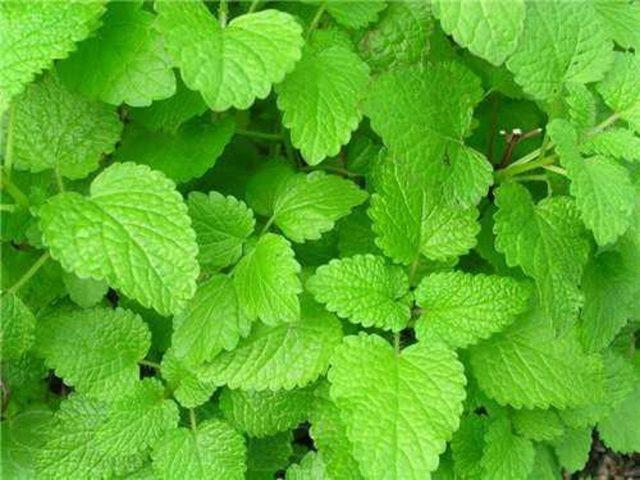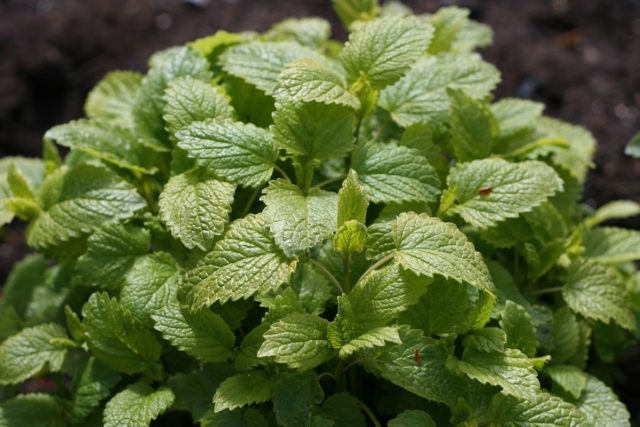Content
Lemon balm or medicinal balm (Melissa officinalis) is a perennial aromatic plant that is a member of the Lamiaceae family. The culture has been known since ancient times. It is widespread throughout the world. The name of the crop means “honey” in Greek; if you rub the grass on the walls of the hive, bees will soon flock to the smell. Lemon balm is valued for its unique aroma and medicinal properties and is used in cooking and folk medicine. It can be grown both in the garden and in the house on the windowsill. Therefore, it is worth studying the description and photo of lemon balm, which will allow you to accurately identify it among many other aromatic plants.

Melissa is a close relative of mint
What does lemon balm look like?
This crop is a branched herbaceous bush and in appearance is in many ways similar to stinging nettle. The plant has tetrahedral branched shoots, the height of which varies between 20-100 cm. The stems of lemon balm are soft-fibrous, covered with short soft hairs. The lower side shoots are creeping type.The root system of the plant is branched and well developed.
According to the description and photo, the leaves of the lemon balm herb are ovoid with petioles, located oppositely on the stems. There is large serration along the edge of the plates. They are covered with glandular hairs. The leaves of lemon balm are light green in color and have a textured surface on which a network of veins is clearly visible.
Where does lemon balm grow in Russia?
On the territory of Russia, the culture is widespread in the Krasnodar Territory and the Samara Region. In nature, lemon balm grows on forest edges, in shady gorges, and ravines. It grows well on loamy and sandy soils rich in organic matter. Prefers moist areas, but is also drought tolerant.
Lemon balm requires a neutral acidity level in the range of 4.5-7.8 pH. In acidic soils, the plant develops poorly and dies quickly. The perennial does well in well-lit areas, but light shading is also allowed. However, in the second case, the grass yield decreases slightly and the aroma becomes less intense.
Frost resistance of this plant is average. With sufficient snow cover and additional insulation for the winter, lemon balm can withstand temperatures as low as -23 °C. However, resistance to frost is lost as the grass ages, so specimens older than five years need to be replaced regularly.
How lemon balm blooms
Lemon balm blooms at the end of June and continues until August. The buds of the plant are collected in false rings of 6-12 pieces. Inflorescences appear in the axils of the leaves in the upper part of the shoots.The lemon balm flower, as seen in the photo, is asymmetrical, the lower petals of the corolla are longer than the upper ones. The color of the buds is bluish-white. Each flower has four stamens and one long pistil with a superior ovary.
The fruits of lemon balm ripen in August-September, namely a month after pollination. They consist of four ovoid nuts, which become shiny black when ripe. On average, the weight of one thousand seeds is 0.062 g.
The appearance of lemon balm is in many ways similar to catnip. However, unlike the latter, it is less winter-hardy. The difference between plants becomes obvious during the flowering period. In catnip, catnip inflorescences are formed purely on the tips of the shoots. Also, the leaves of this plant have a matte gray color.

When propagated by seed, the perennial forms buds in the second year after planting
Melissa varieties with photos and descriptions
Thanks to selection, new varieties of lemon balm have been developed. They differ from each other in the shade of the inflorescences and the color of the foliage. There may also be a difference in the aroma of herbs and its richness. Therefore, in order not to make a mistake with your choice, it is worth studying in more detail the best varieties of lemon balm and their characteristics.
Isidora
This variety of crop forms bushes 85 cm high. The leaves of the lemon balm variety Isidora are medium sized and have a standard ovoid shape. Their edges are moderately serrated and their surface is wrinkled. The Isidora variety is valued for its rich aroma and high yield of green mass. The duration of the period from emergence to cutting of shoots is 50 days. In the first season after sowing, it forms a squat rosette of leaves.The maximum yield of the Isidora variety is observed in the 3-4th year.

It is recommended to plant the Isidora variety according to a 40 by 60 cm pattern
Quadrille
This variety of lemon balm is characterized by compact bushes, 75 cm high, the number of shoots in which reaches 15 pcs. Its distinctive feature is a raised, semi-closed leaf rosette. The plates are medium, rich green in color.
This species belongs to the mid-season category. The weight of one plant is 250 g. The herb has a pleasant rich smell of lemon and a spicy-bitter taste. The period from emergence to harvest is 75-80 days.

The lemon balm variety Quadrille is characterized by a high yield of green mass
Pearl
Mid-season variety of perennial crop. The height of the plant reaches 60-100 cm. The shoots are heavily leafy, the yield of green mass is 4.3-5.8 kg per 1 sq. m. The number of stems in a bush with proper care can reach 40 pieces. The aroma of greenery is rich, lemony. The variety is demanding on watering and fertilizing. During the season you can make 2-3 cuttings.

Melissa Zhemchuzhina has a high content of useful components
Lemon scent
This crop variety belongs to the tall category. The height of its bushes reaches 100-120 cm. The shoots are heavily leafy. Ovoid plates of medium size, light green in color, with a wrinkled surface and obvious jagged edges.
Melissa Lemon aroma mid-season appearance. The harvest can be cut 65-70 days after the sprouts appear in the spring. The yield of green mass is 3.5-4.2 kg per 1 sq. m.

The Lemon aroma variety is demanding on soil fertility and moisture.
Dozya
Melissa Dozya has a raised rosette of leaves. The height of this perennial plant reaches 80-90 cm. The variety is suitable for growing in personal plots and small farms. The period from regrowth to harvesting is 60-65 days.
The leaves of the Dozya variety are dark green in color, standard in shape, with a slightly wrinkled surface and slight pubescence. The weight of the plant in the first year of cultivation is 60-70 g. The aroma is lemon, moderately rich. The variety is recommended for fresh consumption and drying. The yield of green mass for the variety is 3-3.4 kg per 1 sq. m.

The Dozya variety was included in the State Register in 2004 and is recommended for all regions of the country
Tsaritsynskaya Semko
A low-growing compact variety of perennial crop. The height of the fragrant herb barely reaches 50-60 cm. The stems are erect, densely covered with leaves. The blades of the Tsaritsynskaya Semko variety are medium in size, ovoid in shape, with a wrinkled surface and pronounced serration. They have a rich green tint.
The variety is mid-early; harvesting can be done 45-50 days after the sprouts appear. The yield of green mass is 1.5-2.4 kg per 1 sq. m.

The weight of one lemon balm bush Tsaritsynskaya Semko is 150-180 g
Freshness
A medium-sized variety whose shoot height reaches 60 cm. Melissa Freshness is one of the most productive. The plant weight is 500-600 g. The leaves are medium in size, standard in shape, rich green in color. The duration of the period from the appearance of sprouts to cutting is 60 days.Melissa Fresh shows maximum productivity in moderately moist areas with fertile soil in good light. The yield of green mass is 4.2-4.5 kg per 1 sq. m.

Melissa variety Freshness is one of the good honey plants
Pure gold
This variety of perennial herb has a pleasant, rich citrus aroma. The height of its bushes reaches 50 cm. The leaves are medium in size and, with sufficient light, acquire a yellowish tint. Universal application.
The yield of this lemon balm variety is 2.5 kg per 1 sq. m. The period from emergence to cutting is 45-50 days.

Pure gold is an unpretentious species
Conclusion
By studying the description and photo of lemon balm, you can understand exactly what this perennial plant looks like, which will allow you not to confuse it with other similar herbs. This information also makes it possible to select the most optimal variety for cultivation in open ground or at home, depending on the possibility of further care of the crop.








